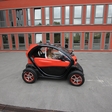
You used to work for a lot of well-known car manufacturers?
Yes, in fact, in my career, I would choose between being freelance, and then I would get fed up when clients wouldn't pay up. And then I'd say, it's time to have a job again. And soon I'm thinking no, this job thing is so restricting, I'm gonna be freelance again. So my career has gone this way and that way... At the moment I'm freelance, I'm still doing some teaching, but almost all the projects I'm doing now are in some way electric-based.
The design of electric cars and the autonomous cars that are coming is changing a lot lately, isn't it? It's not just design anymore, it's more about the user experience.
It's very strange. I think almost all of these companies doing the electric vehicles are probably not making money at the moment, and they are terrified of frightening the customers. So when you look, for example, at Tesla, they make a very nice contemporary car – could be gas, could be diesel, could be electric, because they are worried to scare away regular customers. The brave people – like at BMW – they look for a new design language that would fit the i3, and I like that. And there is no doubt, i8 is much more stylish than Tesla. And in some companies there's a confusion, I think there's a desperation to find a design language that says "I'm electric." And that's how you make a complete mess of things. They are desperately looking for motifs which suggest the car is electric, but they do it with the wheels, so the wheels look like some bit of a household fan and the front grille looks like an old electric fireplace that your grandfather and grandmother might have had. So, they really don't find, I think, language for electric cars. And "electric" is a positive enough thing to be working with, so there has to be a way to find an interesting design language.
Do you think an electric car has to be different from normal cars right now?
I think that, if technology wants to be confident enough, it has to be. At the moment, most people have what the Americans call "range anxiety." For some reason, they think if they run out of electricity, they will die. But they don't think that, if they run out of gas, they will die, so it's a really strange thing. They have this complete anxiety, so the car needs to be confident about its technology, I think. Because with an i3, the message you get is "this is new, interesting technology" – with that car you don't think I'm gonna run out of electricity and die on my way home.
Because it's actually interesting – Tesla, as a completely new manufacturer, goes to classical form, and BMW is a classical manufacturer but has the guts to do something different.
Yes! Renault is halfway there with the Zoey, but the Twizzy absolutely leaves you with no doubt that this is something new, and interesting, exciting, I admire Twizzy for the brave way that Renault has done it.
We could say something similar for Prius?
The Prius is... I call the Prius self-righteous, because it says "Hey, I'm really good, I don't need to be a flashy, interesting car, because I'm such a human car in this world." And the Nissan Micra, even more so. And that's an interesting challenge for designers. I see a lot of student works, and they won't do an electric car... If you do a supercar, you can look at thousands of supercars and you can understand what the design language probably needs to be. You can't really do it with electric cars, and people probably don't think deeply enough "What am I really trying to do here?" Which is the phrase you use, which is a user experience.
Most of the designs I've seen for the eco cars are narrow, tall. The new concept that Shell did with Gordon Murray, for example. Why?
To me that is a tragically wasted opportunity, isn't it? It is an absolutely wasted opportunity. For me, designing a small car is really fascinating, because it's a real challenge, it's a real opportunity to do something fresh and charming. With a small electric car, there is no point in being aggressive, unless you make it look like military equipment. And then you limit yourself to a hundred nutcases who wanna buy something like that, looking like it's from American military, which is equally pointless. So, yes, the Shell thing, I really don't understand it. There is a website, Pistonheads, and they did a review and I really love it. At the end of it, it said "The one thing Gordon Murray design needs to do is talk to Peter Stevens about designing it properly." And I'm thinking, oh god, the next time I see them, they're gonna be looking at me like...
But you are now one of the designers with the most experience in electric and fuel cell cars. You worked with Ecotricity, Riversimple...
We have an English fellow who builds windfarms, Dale Vince from Ecotricity, and he wanted an electric car that would use his wind-generated energy to go from one windfarm to another. So that was really interesting, because we surveyed where his windfarms are, and the maximum distance apart was 120 miles, so that told us what our range had to be. But also he's a petrolhead... He rides a Ducati Monster, he calls himself a "treehugging petrolhead." So, in a way, his character and his requirement set the design parameters for the vehicle, which was really interesting. And in fact, in the experience we had with that, we realized most people are talking nonsense when it comes to electric cars.
When you have to cooperate with engineers, are the electric cars easier to make than the classical ones, or not?
The first thought was that electric cars were liberating to design, because you can put the batteries everywhere. But the batteries they like to all be together, talking to each other. That's the most efficient way. If you put them everywhere, you waste energy... So then you're stuck with a big box. And that is a big constraint, unless you make the floor entirely of the batteries. And the weight: if you take a liter bottle of diesel fuel, the equivalent energy in batteries would be 50 bottles. I like it, because these are challenges and they are different ones than with "normal" cars.
What about the new generation of public transport? Electric buses and infrastructure, for example?
Recently, I've been working with Siemens on a complete system of electric buses. The bus is fantastic, the best vehicle, probably, to make electric. And we do a system of charging the buses at each end of the journey, so I have to design some street furniture, charging stations, which the city needs to find acceptable. And different cities want different things. So, all of that infrastructure is equally fascinating for me. And the bus works really well, because the system we have – instead of 3 tons of batteries, we only need one and a half. So we've saved all this weight, all this money, complexity and everything else, just with a simple re-design of the system, and then that means you can design a bus that doesn't need a space full of batteries, and there's more room for people. All of those aspects are fascinating.
So when you have buses that are going to be charged within the city, you have to connect the design of the vehicles with the design of the city?
Absolutely. On the tram, there is a what you'd call a pentagraph, which touches the overhead wires. On our system, there is an elegant structure and the pentagraph is in the structure, and it comes down onto the roof of the bus, and then it goes away afterwards. In Stockholm, for example, they wanted something really high-tech, really modern-looking. And in Hamburg they wanted it be a bit like it was desgined by Apple. And then Google wanted something that looks like something out of space, so we've done this project at the Google campus. There has to be a charger and a transformer, and that has to suit the character of the city.

What about the interior design? There are a lot of LCD screens, touchscreens, some with a lot of information on them, others with a clean design, with only most necessary information. What would be your way of doing it?
What I think needs to happen is what we did in our electric prototype. Nobody tells you how to drive an electric car in a way that's best for the energy. I worked with an American company called Vectrics, on an electric scooter, and they built them in Poland. Everybody in the company was invited to use the scooter for a week. And they instrumented it completely, so they could see how people rode it, what the average speed was, how much energy they used. And the test driver had the fastest driving speed, but he used the least energy. The guy who was sweeping the floor had the slowest speed, but he used more electricity than anybody else. So the scooter didn't tell you how to ride it in a way that was efficient. So we designed a simple analog dial, and around it we had LEDs, they went in the opposite direction. You could quickly learn to keep the needle and the LEDs separate, as once they crossed over, your range went down really fast.
But it's a question of finding a neat, clean graphical display, instead of having too much information?
Yes, because some cars have, like, a flower which goes red or green, but that's kind of treating the customer like an idiot, really. It's almost like it rewards you at the end. What I love to see in the electric cars is a little read-out that shows how little energy I am using. So instead of when you're drag racing and you want to beat everybody at the traffic lights, you're really smart, because you're only using 3.5 kilowatts. Actually making it a bit competitive, you know? That way, you become involved in the business using less energy, and I really like that idea. I don't know the long-term electric car's future, but burning oil is absolutely not the future.
So touchscreen are the future?
The economics for a company, for a touchscreen, is very cheap. Now, you can buy a screen from China, you know, and it's probably 30 euros, compared with all the switches and other complex functions. There is a degree to which the automotive industry tells us what we need, because it's in its own economic interest that we should want that.
What about designing your own graphics?
The Apple graphic, which is still on my phone, that was a bit three-dimensional, which I quite liked, they then replaced it with something done by a 12-year-old child, and I found that really patronizing, actually. And I think it would be the same with the screen in your car. It's someone else's idea of how you want to get information. The taxi yesterday morning, because the guy didn't know where to go, he had his iPad with a map on it, and he had fitted it into the instrument binnacle, so he couldn't see any of the instruments at all, and it was properly fixed. And I thought, this is really interesting, because for him the information about the car is not necessary for him, he's a taxi driver and wants different information. So, because the car didn't give it to him, he customized it just to do the map. And I thought, of course, really, if the iPad was clever, it would know the engine was overheating and a little thing would come on, and say actually it's more important to top the radiator up, or you're gonna run out of fuel.
This HMI, which is now a trendy thing, the human machine interface, a trendy word – people put up with a lot of stupid systems in a car, actually. They definitely do. In a high-priced car with a lot od functions, most people don't bother to discover how it works, before driving off. And then, suddenly, they don't know what's happening. Is it up, down, push, left, right?
I think, in fact, some of car companies there are the older guys, like me, if you like, who don't want all that connectivity, and don't want people customizing things. I'm opened-minded to say it would be great if drivers had the opportunity to make those decisions. But in fact, it's the opposite – the autonomus car is where you make no decisions, and parts of the industry like it that way.



